
Friends of Fineshade

August's wildlife
1st August. Two Ravens
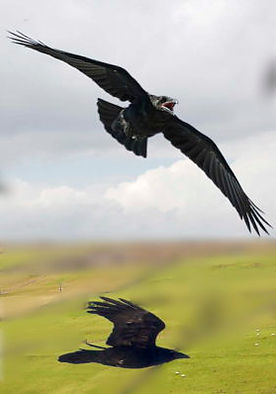
Richard Crossley (The Crossley ID Guide Britain and Ireland) [CC BY-SA 3.0 (http://creativecommons.org/licenses/by-sa/3.0)],
via Wikimedia Commons
For the past few days the wood has been resounding to the harsh cronking of two Ravens: they were particularly noticeable around Top Lodge during the weekend.
We think that one is an adult and another a juvenile and when they fly noisily overhead they are very difficult to miss!
Previously confined to the upland areas of Britain, this largest member of the crow family has been expanding its range eastwards since the 1990s. In this respect it is similar to the Buzzard - both species were almost completely absent from Northants 30 years ago. But things changed and the county bird report for 2002 listed a handful of sighting of Ravens which were thought to be of a single pair. By contrast the 2014 county report had over 300 individual records with breeding success being reported in several locations.
The first known record in Fineshade was in 2007 and since then there have been irregular sightings with some indications that they may have bred here. They nest very early in the year and are silent and secretive until the young leave the nest. In 2010 a pair were seen displaying and later one was seen carrying a stick. In 2013 very young birds were heard and seen in Mill Wood.
It will be interesting to see how long the current pair will remain around the wood.
They look like very big crows - they are actually bigger than Buzzards. Look for the very heavy bill and wedge-shaped tail if they fly overhead but it is the cronking call that will draw your attention to their presence. There is a brilliant BTO video that is really useful in separating Ravens from the various other members of the crow family.
5th August. Another rare beetle
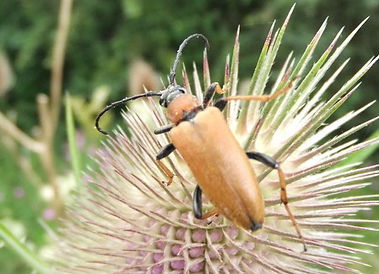
At the beginning of last month an unusual Longhorn Beetle was reported in Fineshade and August has begun with another rarity being discovered in a corner of the wood: it was a female Red Longhorn Beetle (Stictoleptura rubra). This creature was nearly an inch long and clearly enjoying itself on the head of flowering Teasel.
This is an introduced, naturalised species, the larvae developing in the wood of various conifers. The NBN gateway map here shows that the species is very scarcely seen in this part of the world though it occurs more frequently in East Anglia, with the bulk of its population within the Breckland. It appears to have been spreading north and west in recent years and there have been one or two reports in Northants, though, as far as we know, there have been no previous Fineshade records.
This particular individual was alongside the lorry bay at the foot of Mill Wood (where the Gruffalo still stands). That area is particularly rich in insects at the moment, with many butterflies and bees also enjoying the Teasels and other flowers. This afternoon there were also lots of dragonflies - but what we really need is an Odonata specialist to come to help identify and record them.
7th August. Twice girdled teasels

Have you noticed that many teasels have two bands of florets spaced around the flower head? The common Teasel (Dipsacus fullonum) is in full flower in Fineshade at the moment and is attracting all sorts of insect pollinators - shown here are a rather battered Silver-washed Fritillary and what we think is a Tree Bumblebee.
The double girdle of florets is very attractive - but how does it come about? Well, this excellent website says that:
Teasel is unique in the plant world in the way in which it blooms. Flowers form first in a ring around the middle of the head. This ring grows in width over a few days, but since the flowers are relatively short lived, the center of the booming section may die, leaving two rings, one growing towards the top and one towards the bottom of the inflorescence.
That's a clear description of how the girdles are formed. But we still wonder why it occurs. What advantage does this feature give the plant that has made it evolve to flower in this unusual way? Do pollinators find it more attractive?

9th August. Spotted Flycatcher
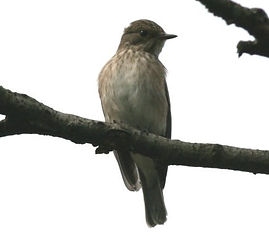
There was a Spotted Flycatcher living up to its name at Top Lodge this morning and we think this is the first one to be seen here this year. (Do please let us know if you've seen one previously.) Until a few years ago this delightfully delicate little bird was a regular sight here and they often nested both in the wood and around the houses at Top Lodge. The old orchard was often a good place to see them and that's where this morning's bird was performing. Watch quitely from the fence near the children's play area and you may see it using a low branch repeatedly to look for flying insects.
Spotted Flycatchers are one of the last summer migrants to arrive in the UK, often not being seen until May. The species has suffered a long-term population decline which is thought to be mainly due to the pressures faced on migration or in its African wintering grounds, though reduction in the number of flies here in the summer may also be relevant.
It is particularly pleasing to see this species still in Fineshade as it is one of the birds that contribute to the case for Fineshade to be notified as a Site of Special Scientific Interest.
14th August. More scarce plants in Westhay Wood

Trailing St John's Wort
Another interesting flower found in two locations during Brian's survey was Round-leaved Fluellen, which is even scarcer in the county. This is an uncommon arable weed and so it was an unexpected find in the wood. No doubt its seed had been dispersed by birds and, like so many other flowers, it has emerged where the soil was disturbed by the recent harvesting work.

This tiny yellow flower caught the eye of Brian Laney as, last Friday, he continued his botanical survey of the rides that were widened last year in Westhay Wood, the southern part of Fineshade. Most of the St John's Wort species are erect and prominent plants, but this one trails low on the ground. It has small (8 to 10 mm) yellow flowers that only open in full sun, meaning it can be easily missed. It only occurs occasionally in Northamptonshire and this is thought to be the first Fineshade record.
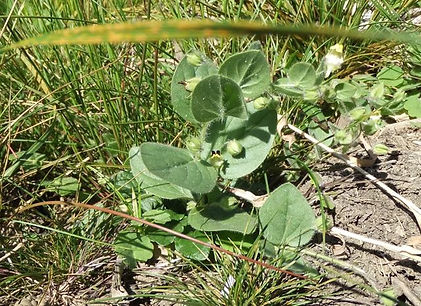
Round-leaved Fluellen
In all, Brian has now recorded 150 flowering plants and grasses during his two visits to survey Westhay Wood. In addition there have been 15 tree species - many regenerating as coppice around the stumps where mature trees have been felled.
One other surprising tree species was discovered this week - a Yew - the photo on the left shows needles on the emerging stems. As far as is known there is no mature Yew tree in the wood so, once again this plant presumably arrived in the form of a seed dispersed by a bird.
The following day Brian led an informal wildflower walk for the Friends of Fineshade.
Emerging stems of Yew
26th August. Seed dispersal
Walk south from the Top Lodge visitor centre along the bridleway towards King's Cliffe and you cannot fail to notice the very large thistles. These are Woolly Thistles (Onopordum acanthium). A few weeks ago they were at their best, with large purple flowers attracting all sorts of insects. The flowers provide essential nectar for the bees, butterflies and moths, but in return the insects help to ensure that seeds are formed by bringing together the female and male parts of the plant.
Now the colourful flowerheads have turned to feather-like thistledown, and wafted in the light summer breezes, the fertile seeds are being dispersed to pastures new. Look carefully and you'll see more Woolly Thistle plants looking like those below without flower heads. It takes the plants two years to come to fruition and there are many one-year old plants like these with prickly rosettes of leaves. These are the result of last year's thistle down and, if they survive they will flower and produce their own seed next year. The prickles of course are the plants' method of deterring mammals from eating them before they can reproduce.

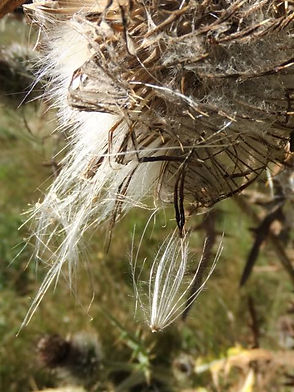

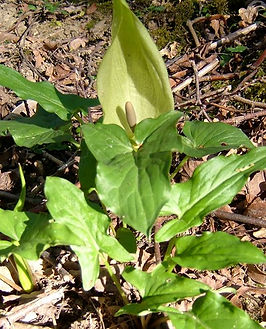
Also near Top Lodge there are plants using a very different technique to disperse their seeds. These bright red berries (left) are all that's left of Lords and Ladies (Arum maculatum). Earlier in the year they looked like this (right). The flowers were partially enclosed in a pale green hood that partially traps insects so that they become dusted with pollen to fertilse the female part of the plant.
Rather than using the wind to disperse fertile seeds, this plant produces luscious looking fruit, a very tempting prospect for mammals and birds. The seeds pass through the animal and are often carried far away to produce more Lords and Ladies next year
However, the berries are extremly harmful to humans - unlike the excellent blackberries that are being picked and enjoyed by so many visitors to Fineshade at the moment.